Technology
In terms of technology there are some differences between various underwater luminaires:
Heat generation and cooling
Underwater lamps with high light output have a certain heat generation. Sufficient cooling of the light source is essential for the life of this lamp. A light source that is too hot will have a much shorter life than a light source which is well cooled. For cooling the water in which the lamp operates can be used. An underwater lamp which is cooled by water should not be used above water, the light source will be damaged due to overheating. There are manufacturers who have lamps fitted with an overheating protection like the TCS (Temperature Control System) by EVA Optic. This automatically switches the lamp in a thermal protection when the LEDs have reached a certain temperature. Once the LEDs are cooled sufficiently, the lamp switches back on automatically.
Electronics
The quality of an underwater lamp depends on many elements, an important part of this being the electronics. A good underwater lamp uses a constant current driver for controlling the light. This affects the performance of the lamp, lamp life and energy ..

Q1 Polyethylene plastic High-power Led underwater light.
consumption and reactive power of the lamp. In the majority of the underwater lights, the electronics are under water inside the fixture. There are also underwater lights with separate driver and power supply which can be placed above water in an area where moisture and heat have no effect. Some LED underwater lights are also dimmable.
Electrolysis
Underwater lighting is available in (high-quality) plastic and stainless steel. With underwater lights of high-quality plastic, the risk of electrolysis is less in comparison to stainless steel. Electrolysis causes a minor current between the pool wall and the stainless steel of the lamp. This current causes corrosion of the stainless steel.
Light color
Light consists of a spectrum of colors in different wavelengths, shown in Newton meters (Nm). The wavelengths that are visible to the human eye are approximately between 380 and 800 Nm (from low to high: blue-green-yellow-orange-red). Water absorbs light in a completely different way than air. This is because the density of water is about 800 times greater than air. This high density ensures that light is absorbed much faster. This absorption of light occurs in one color sooner than other colors. The light color with the highest wavelength in Nm, Red, is underwater almost completely absorbed. This absorption occurs less and less the lower the wavelength in Nm. Therefore, blue light under water has the highest light transmission, outside white which contains all colors in the spectrum.
RGB color and underwater lighting
Underwater lighting is available in several tones of white, mostly bright or daylight white and warm white. There are also underwater lights with a single color or RGB color changing lights. In colored LED lights there are two types of lamps available. The first type uses colored LEDs. These LEDs include only a small part of the full color spectrum and therefore cannot produce white light. The color contrasts are greater, but there are differences in light intensity (red has a much lower light intensity than blue). There are also underwater lights using white LEDs with color filters. The colors are less intense but the light intensity is the same with each color. The colors of surroundings and swimmers also remain the same, this is for public swimming pools often a requirement due to safety regulations.
Color of pool surface
Not only the water itself is responsible for absorption of light from the underwater lamp. The color of the surface of a pool or pond affects the amount of light a fixture yields in a pool. As a general rule, the darker the walls, the less light gets through and the more lights should be used to obtain equal lighting effects.





